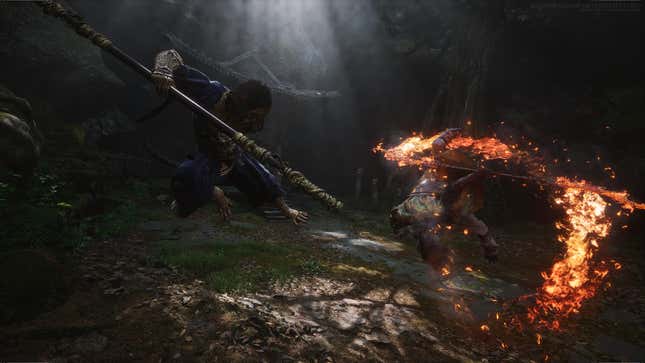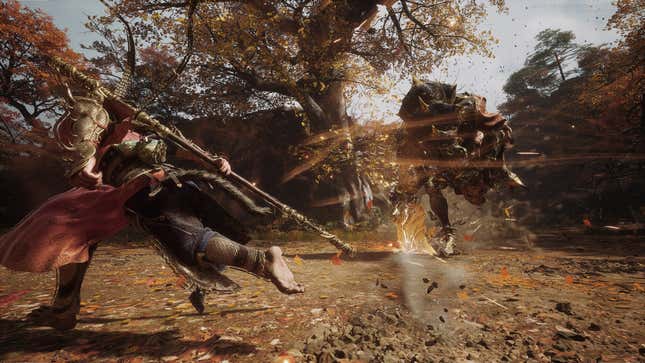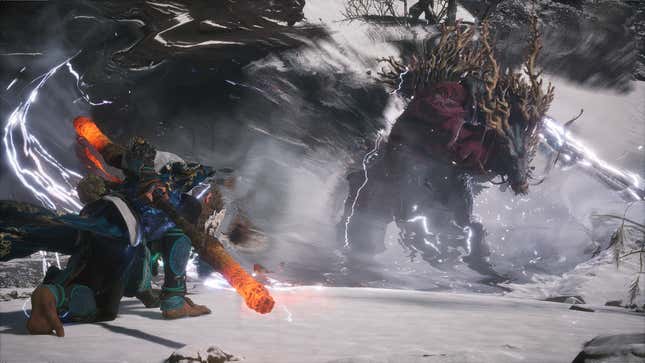There’s a moment in Black Myth: Wukong that would be the perfect visual metaphor for the game’s hopeful, proud ascension as China’s big breakthrough into the Western AAA pantheon. Unfortunately, that moment is restricted, and we can’t talk about that.
There are moments in Black Myth: Wukong of such enthralling beauty and visual poetry and mythmaking unlike almost anything in the current AAA gaming space right now. We can’t show them to you or discuss their contents.
There are reams of lore and mythology and parables and morality plays, dancing with such wild abandon with fantastical, whimsical, imaginative character work and design, giving depth and beauty and context to the otherwise quite obtuse narrative of Black Myth: Wukong. We can’t tell you anything about them.
There is something to be said about the fact that, despite being a rather major, all-encompassing element in the original texts, the goddess Guanyin is such a marginalized part of the game’s narrative. But, while reviewers aren’t restricted on “feminist propaganda” as streamers are, since discussing it requires delving into the particulars of the story–you guessed it–we can’t talk about that.
That leaves precisely two things to really, substantively say about Black Myth: Wukong: It’s extremely pretty, and it’s not trying to ape (ha) FromSoftware’s work as much as you might think. Fortunately and probably not coincidentally, those are the two biggest positives the game has going for it.
A legendary story, retold for those who already know it
For the uninitiated, Black Myth: Wukong is a sort of lopsided retelling of Journey to the West, one of China’s seminal pieces of literature. Imagine if Tolkien had written The Lord of the Rings 400 years earlier, and it was more explicitly about the Crusades and included Bible stories and also Jesus’ apostles were all anthropomorphic animals who God let out on a work-release program, and you have a vague idea of just how important that novel is for China.

The iconography’s managed to sneak out into other cultures from time to time. Most famously, Akira Toriyama’s Dragon Ball universe is chock full of repurposed references to it. For gamers, Ninja Theory’s wonderful, underappreciated Enslaved: Odyssey to the West is perhaps the most direct retelling, though references can be found in everything from Capcom’s Son Son (even moreso in Marvel vs Capcom 2’s reimagining of the character) to Ubisoft’s Beyond Good & Evil. It’s kind of a big deal, is the point here. So, GameScience betting the AAA farm on a big-budget interactive version of that novel as their attempt to graduate China’s games industry past the mobile titles and gacha games that built it in recent years makes total sense. It just would’ve been nice if they bothered to include the rest of us.
Black Myth: Wukong tells the story of Journey to the West in a way that will make absolutely zero sense to anyone not thoroughly and academically versed in Journey to the West. It’s not like it can’t be done in an accessible way; the aforementioned Enslaved manages to do a pretty decent job of it, but also, there’s a very good and very fun film adaptation directed by Stephen Chow of Shaolin Soccer and Kung Fu Hustle fame (it’s on Prime Video right this second, in fact).
Black Myth: Wukong’s telling is sort of a greatest hits package, focusing on a lowly ape warrior known only as the Destined One, who sets out to collect aspects of the fabled Monkey King Sun Wukong in the hopes of resurrecting him in one way or another. That’s all well and good, but Black Myth: Wukong has no interest in taking us on that journey in any cohesive way. There are plenty of erstwhile companions adding color commentary to the journey, some of whom are even endearing. There is lore, and lots of it. Nearly every enemy the Destined One meets gets a lore entry that might as well be its own bespoke novel; many of them are wonderful to read, and most of them have little to no connection to what’s happening in the game at the moment you beat them.
Worse yet, when you do come across characters with personalities and stories worth investing in who are changed by the Destined One’s actions, by the time they get interesting, the Chapter is over, and Chapter breaks will completely interrupt the story at hand and stick the Destined One in a new place, at a new time, with new characters acting like they’ve always been there.
Sure, Souls games have been playing coy with narrative since 2009, but the big difference there is how much of the story is baked into the world itself, its landmarks, its ravished lands, in the designs of the enemies. These biomes, pretty as they are, do not tell stories beyond their innate, natural beauty, at least not in any organic way that conveys reasons to fight for it. There is lore, there is respect for the land itself, but not narrative or storytelling. To belabor the LOTR comparisons, it plays like an Oops! All Appendices cut of the Peter Jackson films, a neverending pile of ancillary details that don’t actually further our understanding of the core story. People who intimately know the original novel will likely be rather pleased by how the game brings its legendary figures to life, and those players can fill in the blanks on where exactly in the story each chapter is meant to take place, but it fails pretty miserably as an on-ramp to everything magical about Journey to the West.
Truly awe-inspiring visuals
At least what’s there is awfully nice to look at. Make no mistake, the game is utterly fucking gorgeous. The game will take you on a whirlwind tour of ancient China, from forest to desert to snowy mountains, and even its most mundane moments of hanging out in nondescript patches of undisturbed nature are absolutely breathtaking in fidelity. The creature design is also top notch, pulling off that latter-day Planet of the Apes-style miracle where you stop seeing the seams of these characters, and you just start seeing the anthropomorphized enemies as believable people of various shapes/sizes/leg counts. It all just feels lifelike and believable. Between this and Hellblade II, Unreal Engine 5 is getting the chance to show off this year, and the results are the first time I’ve truly been awed by a game’s visuals this entire generation.

At least, that was the case when I had the settings cranked all the way up and used Photo Mode, because oh, you bet your ass that beauty has a cost, and even when trying it out on a laptop with an RTX 4090, putting all the settings on Cinematic–the highest setting–with Ray Tracing on felt like a recipe for causing one of those white Akira explosions that birth a universe. It was a struggle. Still, your average player’s gonna be playing on much lesser hardware. The laptop I spent most of my time playing on is running an RTX 3080, and even with most settings just on High and Ray Tracing off, it’s not only still very pretty but relatively steady, though later areas can be a little dicey with the stutters. God help the poor PS5 having to run this thing over 30fps.
Fresh ideas, numerous frustrations
Still, story? Looks? A Souls player craves not these things. Someone who comes into the game looking for that good old FromSoft-style challenge will be…somewhat satisfied, I suppose. The greatest compliment one can pay is that the game is at least thinking about combat mechanics in a way largely unique to itself.
The Destined One’s basic maneuvers involve running, jumping and thwacking enemies with a staff. Far more damaging Heavy attacks are available, but only once you’ve built up enough energy in the small Focus meter in the lower-right of the screen. There are three different stances available, but no variations on the basic combo you spam with each, even with a fairly extensive skill tree. You can sprint, jump, and dodge, but every action costs stamina. You have a flask gourd that you can use to heal on demand. Every enemy drops runes Will, which can be spent on upgrades and items at shrines scattered throughout the world. And the lands are chock full of giant bosses to learn and defeat. It seems, at the outset, like it’s going to play ball like a Souls game, albeit one that hasn’t quite figured out how to make the bread-and-butter basic weapon combat feel genuinely impactful for dozens of hours.
The first time a boss landed a massive hit, sending my heroic monkey friend to the shadow realm with thousands of Will on hand, that old heart-shattering feeling of failure did indeed take hold. I started thinking about the best route to get to my corpse, get my stuff back, and who I’d have to kill again along the way. And that’s when I realized Black Myth: Wukong actually doesn’t punish you for death and you hold onto anything you’ve earned permanently.
Early on, this is a blessing. Especially compared to how Shadow of the Erdtree put the boots to us all medium style a couple months ago, a game of this sort giving its players more license to fuck up is freeing. That’s particularly important once the Destined One’s myriad magic powers come into play and you’re drowning in an overabundance of ways to deal with problems. One of the more brilliant touches that actually ties the game mechanics to its source material is the Transformation system, whereby the Destined One can absorb the energy from particularly difficult and powerful enemies and actually become them, embodying the enemy’s entire moveset, or executing one single, powerful move. That system is fun, rewards experimentation, and introduces vast variety that the basic, spammy staff combat desperately needs.
The magic alone can’t quite uplift Black Myth: Wukong’s combat to the heights it’s aiming for, though. The game remains deeply unbalanced. You have the joy of the Destined One’s powers, offset by how soft and spongy the base combos feel. You have the beautiful environments and the quiet poetry of its major landmarks, which remains enthralling until you realize just how little one can truly wander off the beaten path. Even then, as beautiful as the organic landscape can be, it’s terrible at giving players landmarks to get their bearings or go wandering off in a branching direction without getting locked into a boss fight.

That problem’s compounded by the fact that there’s no in-game map to pick up the slack, and especially in later chapters, checkpoints go from being 5-10 minutes of gameplay away to being 15-20 minutes away. It’s a world of wonderfully realized foes–some of which do manage to punch through to that upper echelon of FromSoft enemy design–who flit between rote pushovers you can light-attack spam to death, and brick walls who will stop you in your tracks for hours on end, with no real flow to how those enemies are placed to maintain the adrenaline of a good stretch of gameplay until the tail end of a chapter.
I want to be able to tell you that the fight is worth it, that getting the game running at the highest settings possible on your rig is worth it, that there are stories worth seeing through to the end, that the white-knuckle adrenaline pumping through your veins for particular bosses is worthwhile, and what rewards await for your victory. Because these things are true, and there is beauty to be found in various places in this game. Without the ability to go into detail, though, we’re left trying to sell you on the least interesting parts of it, the parts that the likes of God of War, Final Fantasy, and Elden Ring offer with much more gratification to be had right from the start.
A game at odds with itself
There is a clear love of a culture, of a myth to be found here, wrapped around a just-okay Souls-lite that’s being made to hold far too much weight on its own. Divorced of all of its pretenses of bringing one of the most famous Chinese myths to life in astonishing detail, Black Myth: Wukong isn’t necessarily a bad time, provided all you truly want and need from the game is to be an angry little magic monkey in a glorified boss rush fighting off various animals who know ancient martial arts. There are enough interesting and delightful ideas at play with its combat system to be worth experiencing as an interesting flavor of Souls-like at bare minimum. But anyone who goes into it with that mindset will find their path deliberately beset by the game’s epic pretenses on all sides. Good, intricate storytelling typically serves to enhance a game like this. Here, the way it’s executed, it’s an ungratifying hindrance, and there’s a lot of it.
Black Myth: Wukong is a game trying to please two very specific crowds. Both will end up doing extra homework to get to the goods in Black Myth: Wukong at every turn, and the game is doing itself no favors by leaving pages out of the textbook. It’s left being big and ostentatious for bigness and ostentatiousness’ sake, when the most exquisite things in it are small, quiet, thoughtful and dream-like. It’s a game whose art is at war with itself, which is awful ironic since Sun Wukong’s whole arc in Journey to the West involves letting go of delusions of grandeur beyond his reach, and living a life of service, meaning, and ego-less contemplation. But, again, there’s not much we can say about how the game handles that. It’s a damn shame. There’s not nearly as much worth saying otherwise. But, so be it. Black Myth: Wukong can just be another forgettable also-ran in a crowded genre. There is nothing else gamers need to hear.
There is no war in Black Myth: Wukong.
.


